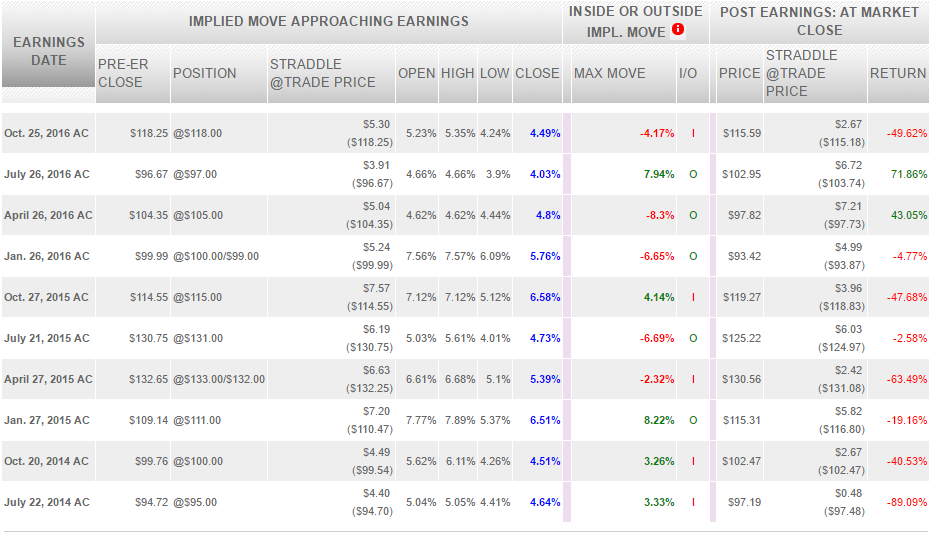
Apple is a company that tends to surprise Wall Street every time it reports its quarterly AAPL earnings, usually on the upside, occasionally on the down. As a result, the stock often makes big moves the next day - sometimes as much as 7-8%. How can you leverage those moves?
Given the power of stock options to leverage your investment dollars, you might be tempted to bet on the AAPL earnings report coming out today by buying Apple calls (if you think the stock is going up) or Apple puts (if you want to bet that it will go down).
That bet paid off handsomely in July 2016 when Apple reported earnings. The stock rose 6.5% the next day and the value of Apple’s weekly calls increased dramatically.
But that’s the exception, not the rule.
As I showed in one of my Seeking Alpha articles, buying either puts or calls just before Apple’s earnings report is, on average, a losing proposition.
When you look at longer timeframe, AAPL tends to move less than expected. Take a look at the screenshot from optionslam.com, showing the post earnings movement of the stock in the last 10 cycles:

The explanation for those numbers is simple. Over time, the options tend to overprice the potential post-earnings move. Those options experience huge volatility drop the day after the earnings are announced. In most cases, this drop erases most of the gains, even if the stock had a substantial move.
The last column shows the one day post earnings performance of the weekly straddle. As we can see, it has lost money 8 out of 10 times. Which means that 8 out of 10 times the stock moved less than expected. If I had to choose, I would take the other side of the trade (selling those options).
Jeff Augen, a successful options trader and author of six books, agrees:
"There are many examples of extraordinary large earnings-related price spikes that are not reflected in pre-announcement prices. Unfortunately, there is no reliable method for predicting such an event. The opposite case is much more common - pre-earnings option prices tend to exaggerate the risk by anticipating the largest possible spike."
"Trying to predict the future is like driving down a country road at night with no headlights on and looking out the back window." - Peter Drucker
Want to learn how to trade options in a less risky way?
What Is SteadyOptions?
Full Trading Plan
Complete Portfolio Approach
Diversified Options Strategies
Exclusive Community Forum
Steady And Consistent Gains
High Quality Education
Risk Management, Portfolio Size
Performance based on real fills
Non-directional Options Strategies
10-15 trade Ideas Per Month
Targets 5-7% Monthly Net Return
Recent Articles
Articles
Pricing Models and Volatility Problems
Most traders are aware of the volatility-related problem with the best-known option pricing model, Black-Scholes. The assumption under this model is that volatility remains constant over the entire remaining life of the option.
By Michael C. Thomsett, August 16

- Added byMichael C. Thomsett
- August 16
Option Arbitrage Risks
Options traders dealing in arbitrage might not appreciate the forms of risk they face. The typical arbitrage position is found in synthetic long or short stock. In these positions, the combined options act exactly like the underlying. This creates the arbitrage.
By Michael C. Thomsett, August 7

- Added byMichael C. Thomsett
- August 7
Why Haven't You Started Investing Yet?
You are probably aware that investment opportunities are great for building wealth. Whether you opt for stocks and shares, precious metals, forex trading, or something else besides, you could afford yourself financial freedom. But if you haven't dipped your toes into the world of investing yet, we have to ask ourselves why.
By Kim, August 7

- Added byKim
- August 7
Historical Drawdowns for Global Equity Portfolios
Globally diversified equity portfolios typically hold thousands of stocks across dozens of countries. This degree of diversification minimizes the risk of a single company, country, or sector. Because of this diversification, investors should be cautious about confusing temporary declines with permanent loss of capital like with single stocks.
By Jesse, August 6

- Added byJesse
- August 6
Types of Volatility
Are most options traders aware of five different types of volatility? Probably not. Most only deal with two types, historical and implied. All five types (historical, implied, future, forecast and seasonal), deserve some explanation and study.
By Michael C. Thomsett, August 1

- Added byMichael C. Thomsett
- August 1
The Performance Gap Between Large Growth and Small Value Stocks
Academic research suggests there are differences in expected returns among stocks over the long-term. Small companies with low fundamental valuations (Small Cap Value) have higher expected returns than big companies with high valuations (Large Cap Growth).
By Jesse, July 21

- Added byJesse
- July 21
How New Traders Can Use Trade Psychology To Succeed
People have been trying to figure out just what makes humans tick for hundreds of years. In some respects, we’ve come a long way, in others, we’ve barely scratched the surface. Like it or not, many industries take advantage of this knowledge to influence our behaviour and buying patterns.

- Added byKim
- July 21
A Reliable Reversal Signal
Options traders struggle constantly with the quest for reliable
By Michael C. Thomsett, July 20

- Added byMichael C. Thomsett
- July 20
Premium at Risk
Should options traders consider “premium at risk” when entering strategies? Most traders focus on calculated maximum profit or loss and breakeven price levels. But inefficiencies in option behavior, especially when close to expiration, make these basic calculations limited in value, and at times misleading.
By Michael C. Thomsett, July 13

- Added byMichael C. Thomsett
- July 13
Diversified Leveraged Anchor Performance
In our continued efforts to improve the Anchor strategy, in April of this year we began tracking a Diversified Leveraged Anchor strategy, under the theory that, over time, a diversified portfolio performs better than an undiversified portfolio in numerous metrics. Not only does overall performance tend to increase, but volatility and drawdowns tend to decrease: